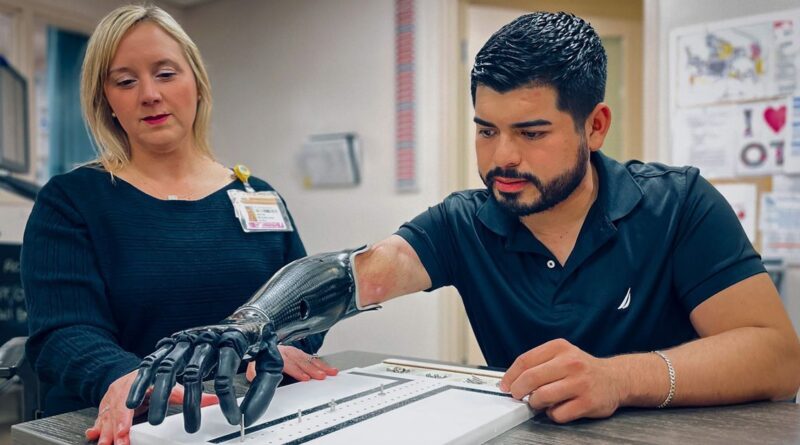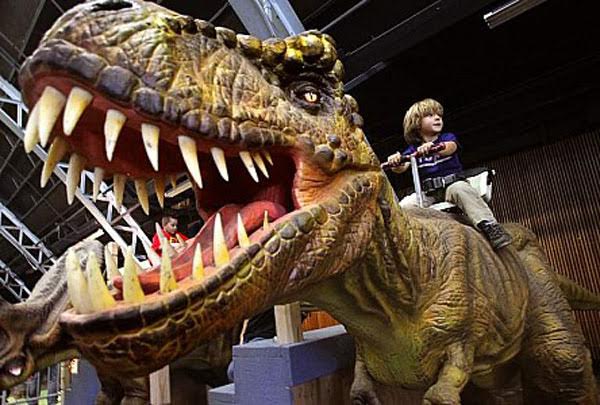Daily Business Report: Jan. 13, 2025
Bionic hand sparks resilience
in patient after electrocution accident
Rehabilitation and prosthesis training at UC San Diego Health invigorate patient’s recovery
Story and Photos by Annie Pierce | UC San Diego
Christian Arreola simply wanted to catch a glimpse of the ocean from the top of his parents’ roof before sunset.
But as he carefully climbed up the wet rafters and crossed beneath an electrical wire overhead, the unimaginable happened — an arc of electric current knocked him to the ground and sent more than 13,000 volts of electricity surging through his body.
“I heard a zooming sound running through my entire body and my muscles were twitching and flexing out of control. It was so painful,” said Arreola, remembering those last terrifying moments before he was knocked unconscious.
Electric arcing can result from various factors, including faulty or deteriorated wiring and loose connections. If an exposed wire makes contact with water, an electric arc can occur. When Arreola stepped beneath the overhead wires on the wet surface, he unknowingly became a conduit.
The energy raged through his body, burning 50% of his chest, back, legs and right arm. From his parents’ home in Rosarito, Mexico, he was taken by ambulance to the US/Mexico border, where he was then transferred to a local ambulance that rushed him to the Regional Burn Center at Hillcrest Medical Center at UC San Diego Health.
Once at Hillcrest Medical Center, his trauma and pain were so severe that doctors recommended a medically induced coma.
“I don’t remember anything about being transported to the hospital, until I signed the paperwork to be put into the coma,” said Arreola, who lives in San Ysidro. “When you get electrocuted, it doesn’t just burn the outside of your body, but also the inside — my kidneys were also severely burned.”
When he awoke from the coma five days later, on March 31, 2022, he learned his right arm and hand needed to be amputated.
“And I said, ‘just go for it,’ because when I went into the coma, I honestly didn’t know if I was ever going to wake up again,” remembers Arreola, who was just 23 years old at the time.
Arreola’s recovery journey was lengthy, with one month spent in the intensive care unit at Hillcrest Medical Center, followed by another three months in the Regional Burn Center. In all, he underwent 20 surgeries for burns and an amputation during his time in the hospital.
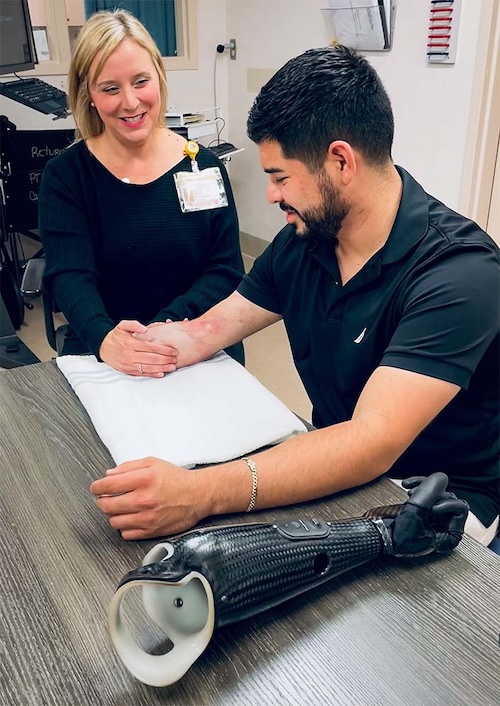
Surgeons initially thought they’d need to amputate all the way to the shoulder, due to his severely burned muscle tissue. But Katharine Hinchcliff, MD, assistant professor of surgery at the University of California San Diego School of Medicine and hand surgeon at UC San Diego Health, worked to salvage as much of the limb as possible.
“I had signed the paperwork to amputate all the way to my shoulder, but each time I’d wake up from surgery, Dr. Hinchcliff said she had removed some of the tissue but wanted to give the remaining tissue more time — and that’s what saved a lot of my arm. I’m so grateful to her for saving as much as she could.”
Hinchcliff explained to Arreola that the more of his arm remained, the easier it would be for him to eventually manipulate a prosthetic hand effectively.
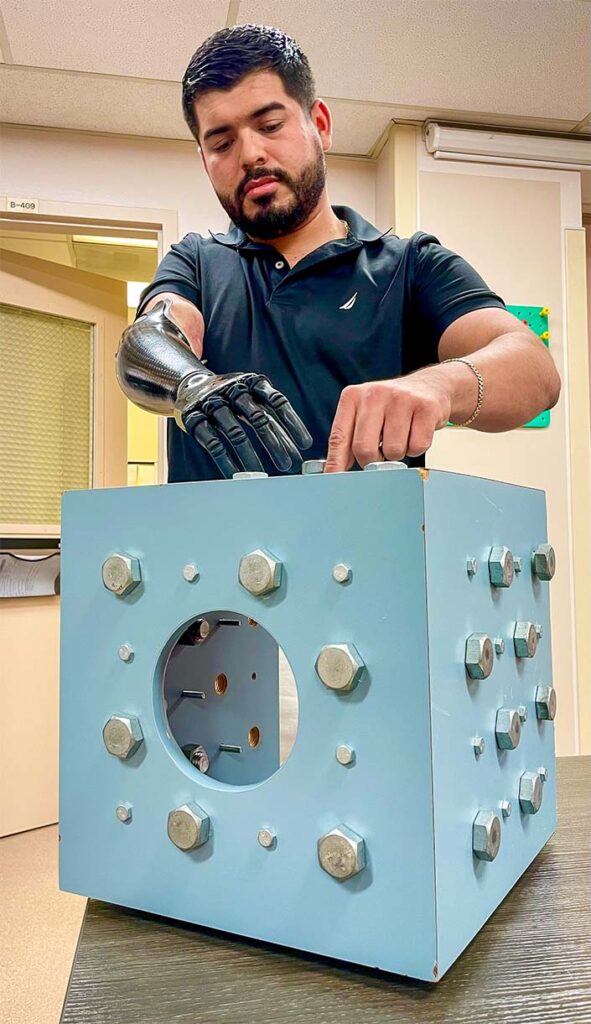
“Trauma amputation surgeries are sometimes thought of as an acute, damage control surgery — and in some ways they are — but they must always be done with the end goal of function in mind,” Hinchcliff said. “Saving Christian’s elbow was so important because that would make his limb much more functional in the future, and his prosthetic adoption higher. It is definitely worth the additional surgeries and reconstruction to give it a shot.”
Near the end of his stay as an inpatient, Arreola met Jennie McGillicuddy, an occupational therapist in physical rehabilitation at UC San Diego Health. She visited him at his bedside in the Regional Burn Center to provide insight about upcoming long-term outpatient therapy work and to share possibilities for a future prosthesis. For the first time since the accident, hope surged through his body.
“To have something so tragic happen at such a young age, it was amazing to see that Christian was so eager to focus on what he could do to push himself forward and heal,” McGillicuddy said. “My initial goal is to never overwhelm a patient with too much information, but instead to help set them up for success as an outpatient in rehabilitation therapy and eventually learn to use a prosthetic. The sooner you can tie therapy work to meaningful activities, the more the patient is going to be motivated.”
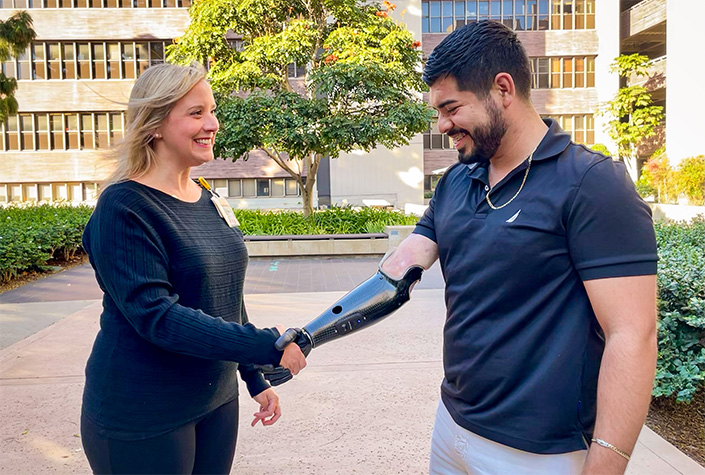
Top Photo: Christian Arreola’s myoelectric prosthetic is controlled by electrical signals generated by specific muscle movements in his residual limb.
Eldridge Enterprises secures Carlsbad industrial building for $1.7 million
JLL announced that it has handled the sale of a 4,397-square-foot industrial building located at 3226 Grey Hawk Court in Carlsbad to Eldridge Enterprise Holdings, LLC for $1,736,000. Eldridge Enterprise Holdings, LLC will use the building to expand its communication technology company with move in expected in 2025 JLL’s Chris Baumgart represented the seller (Grey Hawk 3226, LLC) and buyer (Eldridge Enterprise Holdings, LLC), in the transaction.
According to JLL’s Q3 San Diego Industrial Insights Report, North County San Diego industrial fundamentals remain fairly stable with 6 percent vacancy and 56,199 square feet of quarterly net absorption.
Jurassic Quest returns to Del Mar Fairgrounds
The interactive dinosaur event Jurassic Quest, with the biggest herd of photorealistic dinosaurs, will visit the Del Mar Fairgrounds from Jan. 17-20. Jurassic Quest provides adventure, transporting families through 165 million years of the Triassic, Jurassic, and Cretaceous periods to roam among true-to-life versions of the creatures that once ruled the Earth. Jurassic Quest is filled with hands-on activities and educational events for families.C atch the one-of-a-kind interactive Raptor Training Experience regularly throughout the day, and meet and pet the sweet interactive baby dinosaurs hatched only at Jurassic Quest: Cammie the Camarasaurus, Tyson the T-Rex, and Trixie the Triceratops. Take your family on “The Quest,” a self-guided scavenger hunt-style activity where budding paleontologists can become Jr. Park Rangers, and learn all about the dinosaurs and periods with the help of a fun and fact-filled video tour.
State protections sought for Southern California butterfly
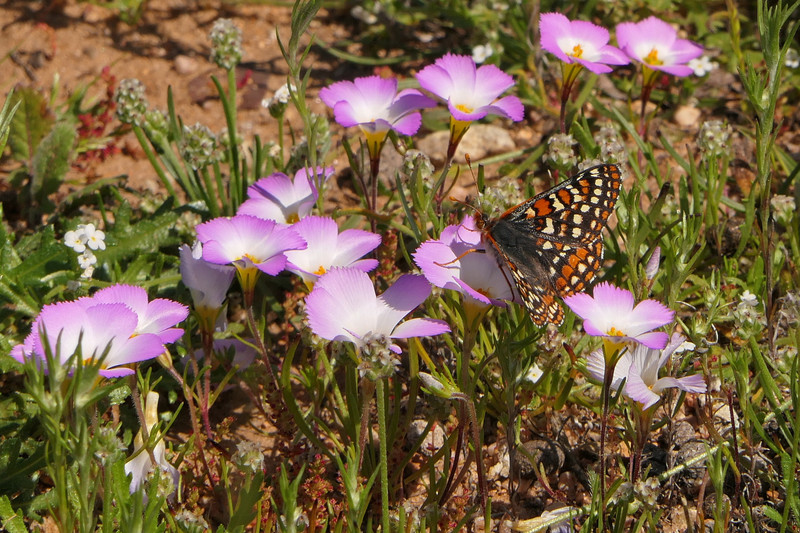
By sdnews.com
The Center for Biological Diversity and Endangered Habitats League petitioned the California Fish and Game Commission recently to list the Quino checkerspot butterfly as endangered under the California Endangered Species Act.
Once common throughout much of Southern California, the Quino checkerspot butterfly, or Quino, has experienced extreme declines over the past 50 years. By the 1980s, more than 75% of its historical range — and almost all its coastal bluff habitat — had been destroyed. The species is now only found in a few small and fragmented populations in San Diego and Riverside counties.
“Quino checkerspot butterflies may be adapted to the unpredictable climate of arid Southern California, but unfortunately they’ve been pushed to the limit by habitat loss and fragmentation,” said Sofia Prado-Irwin, Ph.D., a staff scientist at the Center. “Sprawl development has turned this resilient species into one of the rarest butterflies in California. Their future is dismal without greater protections under state law.”
Quino populations naturally go through boom-and-bust cycles, and connectivity among populations is essential for the species’ survival.
“The small butterfly needs large landscapes to survive. This listing would help preserve the ecosystem the butterflies and many animals depend on,” said Dan Silver, executive director of the Endangered Habitats League.
The Quino’s few remaining populations are threatened by continued sprawl development, climate change, nitrogen pollution, invasive species, and border wall construction. The butterflies have been listed as endangered under the federal Endangered Species Act since 1997, but federal protections have failed to prevent population declines.
Del Mar City Council asks to delay San Dieguito bridge project
The Del Mar City Council is calling on regional leaders to postpone the reconstruction of the San Dieguito Railway River Bridge until after SANDAG has selected a new realignment for the rail tracks.
The new cement San Dieguito bridge will replace the 108-year-old wooden trestle bridge that carries trains over the lagoon, elevating it above the floodplain and double-tracking it for more frequent travel.
The bridge replacement is part of the larger San Dieguito Double Track and Special Events Platform project, adding 2.1 miles of double tracking between Solana Beach and Del Mar.
While the project is fully funded and construction is expected to begin as soon as 2026, the bridge could prove unnecessary depending on the route chosen for the realignment of a 1.7-mile segment of track that currently runs along the unstable Del Mar Bluffs.
$250,000 gramt strengthens Forever Balboa Park
Forever Balboa Park has received a $250,000 grant from the Prebys Foundation that will enable it to increase staffing strength in the areas of fundraising, park improvement expertise, operations efficiency, strategic public relations, and administrative support. The funds come at a critical time as thr organization starts to implement its three-year strategic plan for 2025–2027, helping to quickly grow its capacity to successfully serve Balboa Park in partnership with the city. The new grant brings to $1.25 million the amount awarded in 2024. The organization said it is extremely grateful to all funding partners who recognize and support the vital work that is doneto ensure people and nature thrive together in this very special place.

